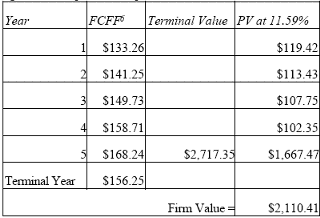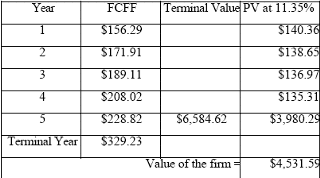In 1997, Digital Equipment, a leading manufacturer of mainframe computers, was the target of an acquisition bid by Compaq, which was at that time the leading personal computer manufacturer in the world. The acquisition was partly motivated by the belief that Digital was a poorly managed firm and that Compaq would be a much better manager of Digital’s assets. In addition, Compaq expected synergies, in the form of both cost savings (from economies of scale) and higher growth (from Compaq selling to Digital’s customers). To analyze the acquisition, we begin with a status quo valuation of Digital. At the time of the acquisition, Digital had the following characteristics:
· Digital had earnings before interest and taxes of $391.38 million in 1997, which translated into a pre-tax operating margin of 3% on revenues of $13,046 million and an after-tax return on capital of 8.51%; the firm had a tax rate of 36%.
· Based upon its beta of 1.15, an after-tax cost of borrowing of 5% and a debt ratio of approximately 10%, the cost of capital for Digital in 1997 was 11.59%. (The treasury bond rate at the time of the analysis was 6%.)
1. Cost of Equity = 6% + 1.15 (5.5%) = 12.33%
2. Cost of Capital = 12.33% (.9) + 5% (.1) = 11.59%
· Digital had capital expenditures[5] of $475 million, depreciation of $ 461 million, and working capital is 15% of revenues.
4. Operating income, net capital expenditures and revenues were expected to grow 6% a year for the next 5 years.
5. After year 5, operating income and revenues were expected to grow 5% a year forever. After year 5, capital expenditures were expected to be 110% of depreciation. The debt ratio remained at 10%, but the after-tax cost of debt dropped to 4% and the beta dropped to 1.
The value of Digital, based upon these inputs, was estimated to be $2,110.41 million.

Note that the terminal value is computed using the free cash flow to the firm in year 6 and the new cost of capital after year 5:
New cost of equity after year 5 = 6% + 1.00 (5.5%) = 11.5%
New cost of capital after year 5 = 11.50%(.9) + 4% (.1) = 10.75%
Terminal value = $156.25/(.1075-.05) = $2,717.35
b. The Value of Corporate Control
Many hostile takeovers are justified on the basis of the existence of a market for corporate control. Investors and firms are willing to pay large premiums over the market price to control the management of firms, especially those that they perceive to be poorly run. This section explores the determinants of the value of corporate control and attempts to value it in the context of an acquisition.
Determinants of the Value of Corporate Control
The value of wresting control of a firm from incumbent management is inversely proportional to the perceived quality of that management and its capacity to maximize firm value. In general, the value of control will be much greater for a poorly managed firm that operates at below optimum capacity than for a well managed firm. The value of controlling a firm comes from changes made to existing management policy that can increase the firm value. Assets can be acquired or liquidated, the financing mix can be changed and the dividend policy reevaluated, and the firm can be restructured to maximize value.
If we can identify the changes that we would make to the target firm, we can value control. The value of control can then be written as: Value of Control = Value of firm, optimally managed - Value of firm with current management The value of control is negligible for firms that are operating at or close to their optimal value, since a restructuring will yield little additional value. It can be substantial for firms operating at well below optimal, since a restructuring can lead to a significant increase in value.
In Practice 26.2: The Value of Control at Digital
We said earlier that one of the reasons Digital was targeted by Compaq was that it was viewed as poorly managed. Assuming that Compaq was correct in its perceptions, we valued control at Digital by making the following assumptions:
· Digital will raise its debt ratio to 20%. The beta will increase, but the cost of capital will decrease. New Beta = 1.25 (Unlevered Beta = 1.07; Debt/Equity Ratio = 25%) Cost of Equity = 6% + 1.25 (5.5%) = 12.88% New After-tax Cost of Debt = 5.25%; the firm is riskier, and its default risk will increase Cost of Capital = 12.88% (0.8) + 5.25% (0.2) = 11.35%
· Digital will raise its return on capital to 11.35%, which is its cost of capital. (Pre-tax Operating margin will go up to 4%, which is close to the industry average)
· The reinvestment rate remains unchanged, but the increase in the return on capital will increase the expected growth rate in the next 5 years to 10%.
· After year 5, the beta will drop to 1, and the after-tax cost of debt will decline to 4%, as in the previous example.
The effect of these assumptions on the cash flows and present values is listed in the following table:

The lower cost of capital and higher growth rate increase the firm value from the status quo valuation of $2,110.41 million to $4,531.59 million. We can then estimate the value of control:
Value of firm (optimally managed) = $4,531.59 million
Value of firm (status quo) = $2,110.41 million
Value of control = $2,421.18 million
--> CC 26.2: Does the fact that the value of control is $2.42 billion imply that this amount is available to be claimed by someone who acquires the firm? Why or why not?
5 The reinvestment rate is therefore artificially low when we look at net capital expenditures. This is because R&D expenses are not capitalized.
6 To estimate FCFF in year 1, FCFF1 = EBIT (1-t) (1+g)-Net Cap Ex (1+g) – Revenue (g) (WC as % of revenues)
= $391.38(1-.36)(1.06) – (475-461)(1.06) - $13,046(.06)(.15) = $133.26 million
Prof. Aswath Damodaran
Next: In Practice 26.3: Value of Control
Summary: Index